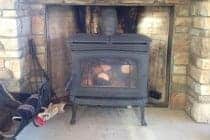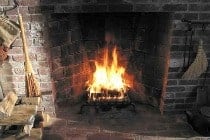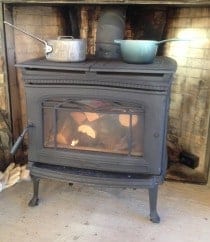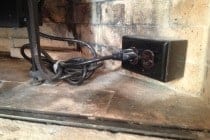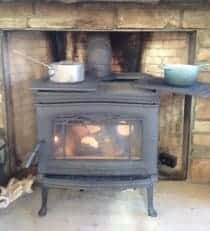After we made the move to a more rural setting, my focus turned to our reliance on the grid and what that meant for our long term survival after some type of catastrophic event. Just being away from people did not provide enough security, we needed to cut the cord.
This is Part II of a series of posts. To read Part I (click here)
SKIP AHEAD
Budgets
Because of budgetary concerns, I focused on the basics first. My first thoughts were about heat. Without heat, our home would become an ice box in the winter. Living in a climate where it was cold 5 months of the year and most of the summer nights dipped into the mid-40’s made me start researching ways for off the grid heat.
A major benefit about living away from the city was that we had almost unlimited access to wood; all you had to do was be willing to chop it. Chopping wood is not an easy task, so in addition to investing in a good axe and chainsaw. I also shared the cost of a wood splitter with my neighbor who also burns wood for heat. The trick about wood is that you have to chop it several months in advance to let it season (dry out) before you burn it. Otherwise, you won’t get the maximum amount of heat from the wood and it will be hard to light on fire. So a little bit of preparedness when it comes to wood goes a long way.
Our home, like many built with in the last 10 to 15 years, focused on natural gas which seems to be abundant and relatively cheap at the moment. With radiant heat throughout our home, as long as the gas keeps flowing and the power stays on, we are set. Remove one of those components and we are screwed.
Rumford Fireplaces
Our home did come with a rumford wood burning fireplace with gas assisted log. We tested the fire place on several occasions and due to the room size and the amount of windows in the home, the rumford proved it was not up to the challenge. The rumford fire place has been around for more than two centuries and in certain types of homes I think it would be sufficient. I think the rumfords are most effective in homes with low ceilings and smaller rooms. Unfortunately, our home had more of an open layout with vaulted ceilings. During out testing, most of the heat from our rumford went right back up the chimney.
Again, because of budgetary concerns, we decided against ripping out the old fire place and instead decided to go with a wood burning free standing stove. This was not an easy choice because we did not know how the wood burning stove would look inside of the existing fireplace. To our surprise it looked quite nice and most people did not know that our fireplace was not designed that way.
When researching the existing brands on the market, I keep reading good reviews about Pacific Energy out of Canada and their baffle technology system that produced almost no smoke. I thought “What a great idea, a stealth fireplace that would not send a smoke signal to the non-prepared that someone was warm and well prepared inside this house.” When I dug deeper into the brand, I found out that they had a cook top model which was ideal for heating large spaces – Alderlea T6. Now I was really happy. Burns wood, puts out almost no smoke, and it could be used to cook dinner. That is a prepper Trifecta. I won’t go in to all of the other details about the Alderlea T6 including the extended burn technology (EBT) but I will say that it lived up to its reputation as a fine stove. No complaints.
In our previous home, we had an Regency Hampton brand fireplace and the quality was also excellent. I didn’t feel like Regency had a comparable match at the time to the Alderlea T6 stove and the T6 stove just fit our needs. We decided ordered the largest firebox made which accepts 18″ to 20” logs and is designed to heat a large room.
Here are the specs for the T6.
Dimensions
Height 29.8125 inches
Width 29.25 in.
Depth 28.75 in.
Flue Distance from Back 8.5 in.
Weight 560 lbs
Technical Information
Heat Output Cord Wood (BTU) 99,000 BTU
Heat Output EPA (BTU) 38,500 BTU
Efficiency 80.5%
Emissions 3.9 gm/hr
Log Size18 – 20 in.
When we first ordered the stove, we decided against the electric fan which fits nicely out of sight on the back of the stove. That was a mistake. After a month of being modestly happy with the amount of heat it put out, we ordered the fan. The fan more that triples the amount of heat circulation we were able to produce with the same amount of wood. It also has a nice feature that turns on the fan when the stove gets to a certain temperature and then shuts off the fan when the stove cools down. The fan is almost fire and forget. If you leave it in the auto position, it will automatically turn on when the stove gets to temperature. The stove will work with or without the fan but if you have power the fan is a nice addition. We had to add an electrical outlet behind the stove which took an electrician just a few hours to put in place.
Cooking
Although our cooking stove in our home works just fine, we decided to test the pacific energy wood burning stove for cooking. It passed the test with flying colors. We have fried eggs, cooked stews, beans, and chili on the stove. It probably goes with out saying but we found the cook top to work better with the circulating fan turned off. It takes more time than cooking on a direct flame but in a pinch you will be happy. Also, for Thanksgiving when you are running out of stove space, you easily have a spot for three more pans. If nothing else, you can use this stove as a place to keep your meals warm.
Our second step to off the grid living was complete. First we moved away from the hustle and bustle of the city. Then we got back to basics of providing reliable heat for our home and for cooking. It was a good feeling to know that even in the worst situation that I could imagine, I would still be able to heat a small room in my house and provide a cooked meal without going outside.
Check out Part 3: Off the Grid Part III – The Back Up Generator


